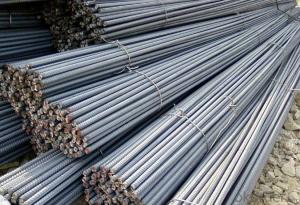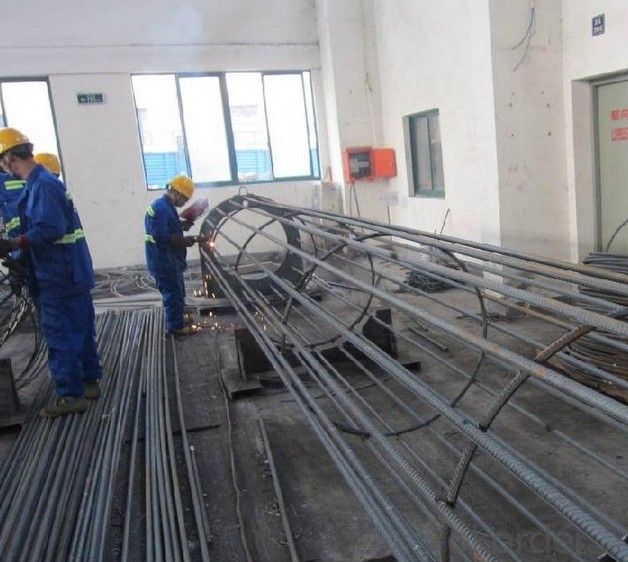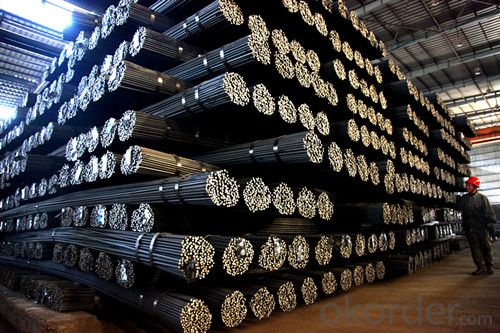High quality hot rolled deformed bar 6mm-50mm ASTM ou BS4449
- Loading Port:
- Tianjin
- Payment Terms:
- TT OR LC
- Min Order Qty:
- 25 m.t.
- Supply Capability:
- 20000000 m.t./month
OKorder Service Pledge
OKorder Financial Service
You Might Also Like
Deformed Bar Details:Product Description:Specifications of HRB400 Deformed Steel Bar:StandardGBHRB400Diameter6mm,8mm,10mm,12mm,14mm,16mm,18mm,20mm,22mm,25mm,28mm,32mm,36mm,40mm,50mmLength6M, 9M,12M or as requiredPlace of originHebei, China mainlandAdvantagesexact size, regular package, chemical and mechanical properties are stable.TypeHot rolled deformed steel barBrand nameDRAGON Chemical Composition: (Please kindly find our chemistry of our material based on HRB500 as below for your information) GradeTechnical data of the original chemical composition (%)CMnSiSPVHRB400≤0.25≤1.60≤0.80≤0.045≤0.0450.04-0.12Physical capabilityYield Strength (N/cm²)Tensile Strength (N/cm²)Elongation (%)≥400≥570≥14 Theoretical weight and section area of each diameter as below for your information: Diameter(mm)Section area (mm²)Mass(kg/m)Weight of 12m bar(kg)628.270.2222.664850.270.3954.741078.540.6177.40412113.10.88810.65614153.91.2114.5216201.11.5818.9618254.52.002420314.22.4729.6422380.12.9835.7625490.93.8546.228615.84.8357.9632804.26.3175.723610187.9998.884012579.87118.4450196415.42185.04 Usage and Applications of HRB400 Deformed Steel Bar: Deformed bar is widely used in buildings, bridges, roads and other engineering construction. Big to highways, railways, bridges, culverts, tunnels, public facilities such as flood control, dam, small to housing construction, beam, column, wall and the foundation of the plate, deformed bar is an integral structure material. With the development of world economy and the vigorous development of infrastructure construction, real estate, the demand for deformed bar will be larger and larger.. Packaging & Delivery of HRB400 Deformed Steel Bar: Packaging Detail: products are packed in bundle and then shipped by container or bulk vessel, deformed bar is usually naked strapping delivery, when storing, please pay attention to moisture proof. The performance of rust will produce adverse effect. Each bundle weight: 2-3MT, or as required Payment term: TT or L/C Delivery Detail: within 45 days after received advanced payment or LC. Label: to be specified by customer, generally, each bundle has 1-2 labels Trade terms: FOB, CFR, CIF
|
- Q:What is the recommended method for tying steel rebars together?
- The recommended method for tying steel rebars together is to use wire or rebar tying tools to secure the bars in a tight and sturdy manner, ensuring proper reinforcement in construction projects.
- Q:Can steel rebars be used in high-strength concrete?
- Yes, steel rebars can be used in high-strength concrete. In fact, steel rebars are commonly used to reinforce concrete structures, regardless of the concrete strength. High-strength concrete refers to concrete that has a compressive strength significantly higher than conventional concrete. It typically has a compressive strength of 6,000 psi (pounds per square inch) or more. Steel rebars are essential in high-strength concrete to provide the necessary tensile strength. While concrete has excellent compressive strength, it is relatively weak in tension. By incorporating steel rebars into the concrete, the composite material becomes stronger and more durable. The rebars act as reinforcement, resisting the tensile forces and preventing cracks or failure in the structure. However, it is important to note that the selection of the appropriate steel rebar for high-strength concrete is crucial. The rebars used should have sufficient strength and ductility to withstand the higher stresses and strains associated with high-strength concrete. Additionally, proper placement, spacing, and anchorage of the rebars are essential to ensure effective reinforcement and optimal performance of the concrete structure. In summary, steel rebars can definitely be used in high-strength concrete to enhance its tensile strength and overall structural integrity.
- Q:Are there any specific guidelines for storing and handling steel rebars?
- Yes, there are specific guidelines for storing and handling steel rebars. These guidelines typically include storing rebars on a flat surface to prevent bending and distortion, keeping them off the ground to prevent rusting, and protecting them from moisture and exposure to chemicals. Additionally, rebars should be handled with care to avoid any damage or injury, and they should be stored in a well-organized manner to ensure easy identification and retrieval.
- Q:How do steel rebars contribute to the seismic performance of a structure?
- Steel rebars contribute to the seismic performance of a structure by enhancing its strength and ductility. When embedded in concrete, rebars act as reinforcement, providing tensile strength to resist the forces generated during an earthquake. This reinforcement helps prevent cracking and failure in the concrete, allowing the structure to better absorb and dissipate seismic energy. Additionally, the flexibility and high yield strength of steel rebars enable them to deform and absorb seismic forces, reducing the likelihood of structural collapse during an earthquake.
- Q:How do steel rebars help in load distribution within a structure?
- Steel rebars, also referred to as reinforcing bars, are essential for the distribution of loads within a structure. They are extensively utilized in concrete structures, like buildings, bridges, and highways, to enhance their strength and durability. The main objective of steel rebars is to provide tensile strength to the concrete. While concrete is highly capable of withstanding compression, it is relatively frail when it comes to tension. Any structure exposed to loads, whether from the weight of the building itself or external forces, will encounter both compression and tension forces. By incorporating steel rebars into the concrete, they act as reinforcements and resist tensile forces. When an external load is applied to the structure, the rebars bear a significant portion of the generated tension forces. This prevents the concrete from cracking or failing under the applied load. Furthermore, steel rebars aid in the distribution of the load throughout the structure. When a load is imposed on a structure, it generates stress that is spread across the various components. The presence of rebars enables a more uniform distribution of these stresses, reducing the concentration of forces in specific areas. This prevents localized failures and ensures that the load is evenly dispersed across the structure, thereby improving its overall strength and stability. Another crucial aspect of steel rebars is their capacity to bond with concrete. The rough surface of the rebars prevents them from slipping or separating from the concrete, ensuring a robust bond between the two materials. This bond further enhances the distribution of loads by enabling the rebars to effectively transfer the tensile forces to the surrounding concrete. In conclusion, steel rebars play a critical role in the distribution of loads within a structure. They furnish the necessary tensile strength to withstand tension forces, distribute the load evenly across the structure, and bond with the concrete, guaranteeing a sturdy and stable construction. Without steel rebars, concrete structures would be considerably weaker and more prone to cracking or failure under load.
- Q:What is the difference between hot-rolled and cold-rolled steel rebars?
- The main difference between hot-rolled and cold-rolled steel rebars lies in the manufacturing process. Hot-rolled steel rebars are created by heating the steel billets and passing them through rollers to shape them into the desired form. This process results in a rougher surface and a larger diameter tolerance. On the other hand, cold-rolled steel rebars are manufactured by cooling the steel billets and then passing them through rollers at room temperature. This process produces a smoother surface and a more precise diameter tolerance. Overall, the choice between hot-rolled and cold-rolled steel rebars depends on the specific requirements of the application.
- Q:How are steel rebars protected from damage during handling and transportation?
- Steel rebars are typically protected from damage during handling and transportation through various methods such as bundling, strapping, and using protective caps or covers. Additionally, they are often stored and transported in specialized containers or pallets to prevent any potential bending, scratching, or other forms of physical damage.
- Q:What is the role of steel rebars in preventing concrete creep?
- The prevention of concrete creep relies heavily on the involvement of steel rebars. Concrete creep is the gradual movement or deformation of concrete over time when subjected to sustained load. This phenomenon occurs due to the long-term stress on the concrete, causing it to slowly deform and creep. To counteract this creep behavior, steel rebars, which are reinforced steel bars, are utilized in concrete structures. They play a significant role in preventing concrete creep by providing tensile strength and reinforcing the structure. When concrete is under a load, it experiences both compressive and tensile forces. While concrete can withstand compressive forces effectively, it is relatively weak in tension. This is where steel rebars come into action. By inserting steel rebars within the concrete, the tensile strength of the structure is greatly improved. Steel possesses high tensile strength, making it an ideal material for bearing the tension experienced by the concrete. As the concrete begins to creep under a sustained load, the steel rebars resist deformation and distribute the tensile forces throughout the structure. The presence of steel rebars restrains excessive deformation of the concrete, thus reducing the potential for long-term creep. By reinforcing the concrete with steel rebars, the structure becomes more resistant to creep and maintains its stability and integrity over time. Additionally, steel rebars enhance the overall durability and structural performance of the concrete. They improve the load-bearing capacity, prevent cracking, and enhance resistance against external forces like earthquakes or environmental factors. In conclusion, the significance of steel rebars in preventing concrete creep lies in their ability to provide tensile strength and reinforce the structure. They resist deformation of the concrete under sustained load, ensuring its stability and long-term integrity. The utilization of steel rebars greatly enhances the durability and structural performance of concrete structures, making them more resistant to creep and other potential issues.
- Q:What is the effect of moisture content on the strength of steel rebars?
- The moisture content of steel rebars can have a detrimental effect on their strength. When exposed to moisture, steel rebars can corrode, leading to a reduction in their strength and structural integrity. Corrosion causes the formation of rust, which weakens the steel rebars by gradually deteriorating their surface and compromising their load-bearing capacity. Therefore, it is essential to prevent moisture from coming into contact with steel rebars to maintain their strength and durability in construction projects.
- Q:How do steel rebars affect the overall constructability of a project?
- Steel rebars play a crucial role in enhancing the overall constructability of a project. They provide structural strength and stability to concrete structures, improving their durability and load-bearing capacity. By reinforcing concrete, rebars help prevent cracking, enhance resistance to tension forces, and increase the project's lifespan. Additionally, rebars enable the construction of complex shapes and designs, allowing for more versatile and innovative architectural designs. Overall, steel rebars significantly contribute to the construction process by ensuring the integrity and longevity of the project.
1. Manufacturer Overview |
|
|---|---|
| Location | |
| Year Established | |
| Annual Output Value | |
| Main Markets | |
| Company Certifications | |
2. Manufacturer Certificates |
|
|---|---|
| a) Certification Name | |
| Range | |
| Reference | |
| Validity Period | |
3. Manufacturer Capability |
|
|---|---|
| a)Trade Capacity | |
| Nearest Port | |
| Export Percentage | |
| No.of Employees in Trade Department | |
| Language Spoken: | |
| b)Factory Information | |
| Factory Size: | |
| No. of Production Lines | |
| Contract Manufacturing | |
| Product Price Range | |
Send your message to us
High quality hot rolled deformed bar 6mm-50mm ASTM ou BS4449
- Loading Port:
- Tianjin
- Payment Terms:
- TT OR LC
- Min Order Qty:
- 25 m.t.
- Supply Capability:
- 20000000 m.t./month
OKorder Service Pledge
OKorder Financial Service
Similar products
New products
Hot products
Related keywords
































